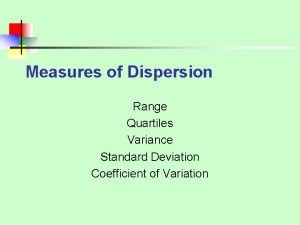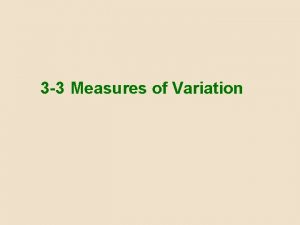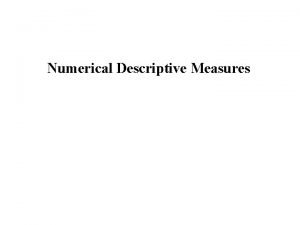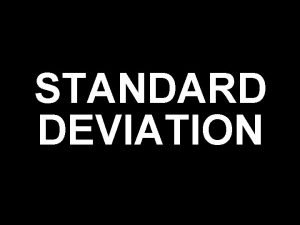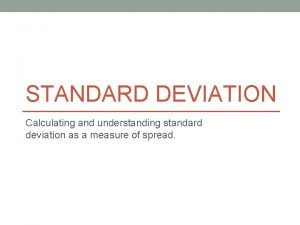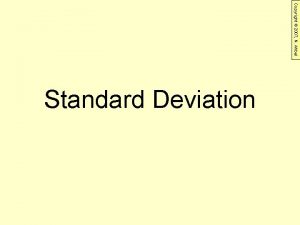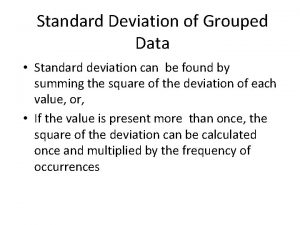12 4 Standard Deviation Measures of Variation The












- Slides: 12

12. 4 – Standard Deviation

Measures of Variation The range of a set of data is the difference between the greatest and least values. ¡ The interquartile range is the difference between the third and first quartiles ¡

Example There are 9 members of the Community Youth Leadership Board. Find the range and interquartile range of their ages: 22, 16, 24, 17, 16, 25, 20, 19, 26. greatest value – least value = 26 – 16 Find the range. = 10 median Find the median. 16 16 17 19 20 22 24 25 26 (16 + 17) 2= 16. 5 Q 1 = Q 3 = (24 + 25) = 24. 5 2 Find Q 1 and Q 3 – Q 1 = 24. 5 – 16. 5 Find the interquartile range. = 8 The range is 10 years. The interquartile range is 8 years.

More Measures of Variation ¡ Standard deviation is a measure of how each value in a data set varies or deviates from the mean

Steps to Finding Standard Deviation 1. Find the mean of the set of data: 2. Find the difference between each value and the mean: 3. Square the difference: 4. Find the average (mean) of these squares: 5. Take the square root to find the standard deviation

Standard Deviation Find the mean and the standard deviation for the values 78. 2, 90. 5, 98. 1, 93. 7, 94. 5. (78. 2 + 90. 5 + 98. 1 +93. 7 +94. 5) x = = 91 Find the mean. x 78. 2 90. 5 98. 1 93. 7 94. 5 x 91 91 91 5 x–x – 12. 8 – 0. 5 7. 1 2. 7 3. 5 (x – x)2 163. 84. 25 50. 41 7. 29 12. 25 Organize the next steps in a table. = = (x – x)2 Find the standard n deviation. 234. 04 5 The mean is 91, and the standard deviation is about 6. 8

Let’s Try One – No Calculator! Find the mean and the standard deviation for the values 9, 4, 5, 6 x x Find the mean. x x–x (x – x)2 Organize the next steps in a table. = (x – x)2 Find the standard n deviation.

Let’s Try One – No Calculator Find the mean and the standard deviation for the values 9, 4, 5, 6 x = x 9 4 5 6 (9+4+5+6) Find the mean. 4 = 6 x x–x 6 3 6 -2 6 -1 6 0 sum (x – x)2 9 4 1 0 Organize the next steps in a table. = 14 (x – x)2 Find the standard n deviation. The mean is 6, and the standard deviation is about 1. 87.

More Measures of Variation ¡ Z-Score: The Z-Score is the number of standard deviations that a value is from the mean.

Z-Score A set of values has a mean of 22 and a standard deviation of 3. Find the z-score for a value of 24. value – mean z-score = standard deviation = 24 – 22 3 Substitute. = 2 3 Simplify. = 0. 6

Z-Score A set of values has a mean of 34 and a standard deviation of 4. Find the z-score for a value of 26. value – mean z-score = standard deviation = 26 – 34 4 Substitute. = -8 4 Simplify. = -2

Standard Deviation Use the data to find the mean and standard deviation for daily energy demands on the weekends only. S 33 39 33 33 40 47 45 40 M 53 41 49 45 40 T 52 44 54 42 41 The mean is about 36. 1 MWh; the standard deviation is about 3. 6 MWh. W 1: Use the STAT feature Th F S Step 47 47 50 39 to enter the data as L 1. 47 49 43 Step 53 2: Use the CALC menu of 46 36 STAT to access the 43 39 33 42 1 -Var Stats option. The mean is x. The standard deviation is x.
 Mean absolute deviation formula excel
Mean absolute deviation formula excel Variance standard deviation
Variance standard deviation Standard error for mean
Standard error for mean Prediction interval formula
Prediction interval formula What does a direct variation graph look like
What does a direct variation graph look like Examples of direct variation graphs
Examples of direct variation graphs Measures of variation definition
Measures of variation definition Measures of variation
Measures of variation Measures of central tendency and variation
Measures of central tendency and variation Measures of central tendency and variation
Measures of central tendency and variation Repeated measures design
Repeated measures design Standard deviation of p hat
Standard deviation of p hat Standard deviation
Standard deviation

